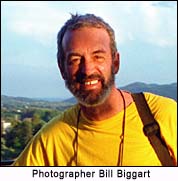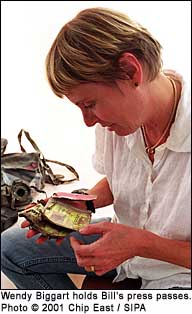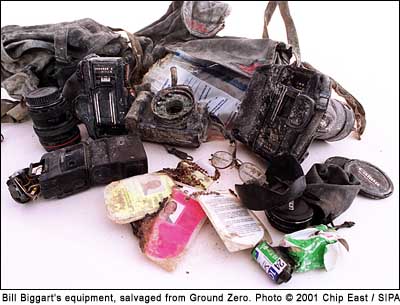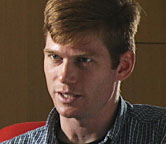|
"Bill
Biggart's Final Exposures"
By Dirck Halstead
 Photographer
Chip East was staring intensely at his laptop screen. Photographer
Chip East was staring intensely at his laptop screen.
It was two weeks after two jetliners had plowed into the towers of the
World Trade Center. His good friend, photojournalist Bill Biggart's
body had been recovered from the rubble. His personal effects, including
his cameras had been released by authorities to his widow, Wendy.
Biggart. a photographer, who had worked for an alternative New York
picture agency, had been carrying three cameras with him, when he left
his home in Manhattan that sparkling Tuesday morning, and started walking
south towards the plumes of smoke. There were two Canon EOS1s film cameras.
He was also carrying his Canon D30 digital camera. For Biggart, mastering
the new techniques of digital photography had been a break-through.
When Chip East was handed the bag containing Biggart's gear by his widow,
Wendy, he was convinced that no pictures had survived. The avalanche
of falling debris had blown off the backs of the two film cameras. There
were several rolls of film in Biggart's bag; however, the lids of the
film canisters had been peeled back, allowing light to fall into the
cassettes. Finally, East turned his attention to the digital camera.
It was covered by ash. The lens had been sheared off at the flange.
But when he opened the chamber that held the compact flash card, it
was pristine.

|

|
He slipped the
flash card into his computer reader, and tried to open it. At first,
it refused to open, East kept mumbling, "come onScome on!"
He rebooted his computer, and suddenly three folders opened on his desktop.
They contained all the last images that Bill Biggart would ever take.
Now, looking at the photographs, it is possible to retrace Biggart's
last hour of life, as he works his way ever closer to Ground Zero.
Here, Chip East takes over the story:
"As you scroll through 150 pictures or so, you are not only just
looking at a guy on the street making deliberate pictures, but they
are framed a certain way, tells us something about the photographer
as well. In this first frame we see trees, and the buildings in Manhattan
framing the burning World Trade Center. I think a lot of people would
have photographed that tight, and looked at just the main story. But
to see it framed by a part of New York as he was walking through Greenwitch
Village is somewhat symbolic of Bill Biggart and how he made pictures.
Also, the fact that he was from New York, and with trees in the pictures,
I don't know, maybe it is inferring too much, but it means a lot to
see foliage, and to see one of his other passions (trees) in the first
pictures.
 "As
I looked at them for the first time, it wasn't just the pictures, but
I was looking around and listening to those of us who were at Bill’s
studio. Hearing Bill's wife, Wendy, saying things like, ‘Oh Damn,
Bill, why are you so close;?’ really meant something too. Here
we were two weeks after he was killed, and she was still talking to
him, through his pictures. "As
I looked at them for the first time, it wasn't just the pictures, but
I was looking around and listening to those of us who were at Bill’s
studio. Hearing Bill's wife, Wendy, saying things like, ‘Oh Damn,
Bill, why are you so close;?’ really meant something too. Here
we were two weeks after he was killed, and she was still talking to
him, through his pictures.
"As you get
there, the unique angle of looking straight up at the buildings, you
never saw that from anybody else. As you go through the timestamps,
the cloud of dust comes towards you. You just see this massive cloud
framed with fire trucks and police cars, and firemen and policemen.
"So we are
looking at the cloud coming towards Bill and the 30 seconds worth of
pictures that Newsweek did from 9:59:10 to 10:00:08, which is basically
when the first cloud covered him. In the pictures, he frames up when
the cloud is right on him, and you still have the North tower, framed
right in there.
"He is going closer and closer, as you go through, you see peoples
reaction, and you see how people are handling all this... every one
of Bill's pictures are about people and how they are reacting to this
story. We need to remind ourselves this story isn't about buildings,
but about how people are effected by the loss of these structures.
 "So
we track through to the end, and we see the second to the last frame.
He is moving forward, he is walking down West street, and he is moving
towards the pedestrian overpass connecting the World Trade Center and
the World Financial Center. Bill is getting closer and closer, and you
see more firemen and fire trucks and the second to the last frame you
see policemen, and fire trucks under the overpass. "So
we track through to the end, and we see the second to the last frame.
He is moving forward, he is walking down West street, and he is moving
towards the pedestrian overpass connecting the World Trade Center and
the World Financial Center. Bill is getting closer and closer, and you
see more firemen and fire trucks and the second to the last frame you
see policemen, and fire trucks under the overpass.
"And then you see the last frame that nobody else will ever have.
You see the honeycomb pieces of the first building... and we see half
of the hotel that was destroyed as well. After the second building fell,
the hotel, the Marriott I think, was gone. You see it cut in half from
what fell from the first building and it is time stamped 10:28 and 24
seconds. Basically that time stamp is the end, because at 10:30 is when
the second building came down.
"Bill was killed when the second building came down, and he was
crushed under all the debris. I don't know if he jumped back under the
underpass, or whether the direct debris killed him. We know in his last
picture he was working to the very end, and that's telling of the commitment
he had to his work."
|

 Photographer
Chip East was staring intensely at his laptop screen.
Photographer
Chip East was staring intensely at his laptop screen.

 "As
I looked at them for the first time, it wasn't just the pictures, but
I was looking around and listening to those of us who were at Bill’s
studio. Hearing Bill's wife, Wendy, saying things like, ‘Oh Damn,
Bill, why are you so close;?’ really meant something too. Here
we were two weeks after he was killed, and she was still talking to
him, through his pictures.
"As
I looked at them for the first time, it wasn't just the pictures, but
I was looking around and listening to those of us who were at Bill’s
studio. Hearing Bill's wife, Wendy, saying things like, ‘Oh Damn,
Bill, why are you so close;?’ really meant something too. Here
we were two weeks after he was killed, and she was still talking to
him, through his pictures. "So
we track through to the end, and we see the second to the last frame.
He is moving forward, he is walking down West street, and he is moving
towards the pedestrian overpass connecting the World Trade Center and
the World Financial Center. Bill is getting closer and closer, and you
see more firemen and fire trucks and the second to the last frame you
see policemen, and fire trucks under the overpass.
"So
we track through to the end, and we see the second to the last frame.
He is moving forward, he is walking down West street, and he is moving
towards the pedestrian overpass connecting the World Trade Center and
the World Financial Center. Bill is getting closer and closer, and you
see more firemen and fire trucks and the second to the last frame you
see policemen, and fire trucks under the overpass.